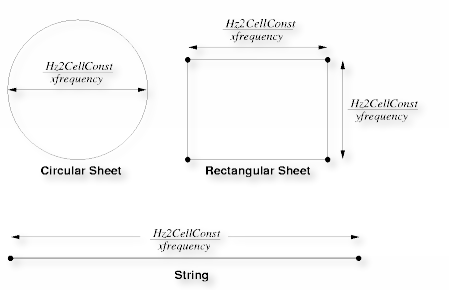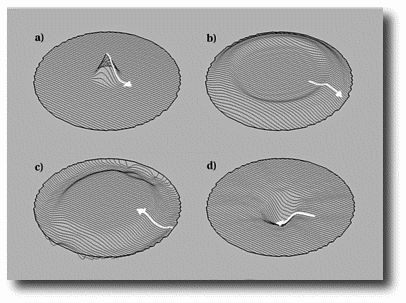
Instruments and Devices

The Stop Device

Access Points
The Information Needed to Create an Instrument
When a new instrument is created three pieces of information are required from the user in the case of rectangular and elliptical sheets and two in the case of strings and circular sheets. These are:
- A frequency or pitch specifying the dimensions of the instrument in the x direction
- A frequency or pitch specifying the dimensions of the instrument in the y direction (for rectangular and elliptical sheets only)
- A decay time
The dimensions of a new instrument are always described in terms of pitches or frequencies rather than physical units such as metres or millimetres. For example when creating a new string the pitch specified is used to determine the length of the string. You may be thinking `what about the tension in the string?', but in Tao's cellular material the tension is fixed at an optimum value which gives the best frequency response, so the only factor affecting the pitch of a string is its length and vice versa.
In the case of a rectangular sheet two pitches or frequencies are required. The first relates to the time taken for a wavefront to make the round trip from the left hand side of the sheet to the right and back again (travelling in the x direction). The second relates to the time taken for a wavefront to make the round trip from the bottom to the top and back again (travelling in the y direction).

The precise relationship between the frequencies and dimensions of the
various instrument types is illustrated by figure *.
The constant Hz2CellConst is defined by Tao and is used to
translate a frequency into the appropriate number of cells required
to produce that frequency of vibration.
In order to explain this more clearly figure *
shows four snapshots of a circular sheet having had a short impulse
applied at its centre. The white arrows
indicate part of the wavefront traveling across the sheet in the
x direction, reflecting back off the boundary and eventually
ending up back at the starting point again. Once the wavefront has
traveled all the way to the other side of the sheet and then back
to the centre again it has made one round trip. The speed of wave
propagation is fixed for Tao's material so the Hz2CellConst
constant can be used to calculate how many cells it takes to produce
the correct period T, and hence frequency 1/T.

The final piece of information required by all new instruments is a
decay time, the time taken for vibrations to naturally die away
when the instrument is excited in some way and then left to vibrate
freely. The value given is used to calculate a default value
for the velocityMultiplier attribute of each cell. This initially
gives the instrument uniform damping although this uniform behaviour
can be subsequently altered by damping local regions of the instrument.
More of this technique in section [TO DO: WRITE THIS SECTION].

Instruments and Devices

The Stop Device

Access Points